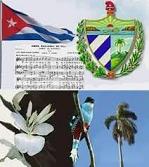Los símbolos nacionales merecen respeto

Por Andy Duardo Martín
(English version at the end of the text)
Preocupante, así defino la tendencia a la adoración de símbolos extranjeros, mientras se desconocen o menosprecian los propios. El asunto no es competir, o sea, hacer con los nuestros lo mismo que se practica en otras naciones.
Apoyo a quienes coinciden en la necesidad de repensar el asunto, ante una sociedad que dista mucho de aquella que aprobó la Ley de los Símbolos Nacionales y su Reglamento, emitidos en la década de los 80 del siglo pasado.
¿Puede un cubano envolverse en la enseña nacional, llevarla en una prenda de vestir, utilizarla como distintivo o tatuarla en el rostro? ¿Puede estar colgada día y noche a la entrada de una institución o de una vivienda?
La respuesta a esas interrogantes en las disposiciones actuales sería la negativa, como también a las escenas que vemos a diario de nuestra bandera adornando cientos de vehículos junto a la de otros países, o grabadas en suvenires, camisetas o bolsos.
Imágenes que no concuerdan con lo dispuesto acerca del uso de nuestra enseña nacional se ven a diario en las calles, como también se le observa reproducida con los más diversos diseños y tonalidades de colores. Todo ello está prohibido, por la Ley.
Con el Himno Nacional existen irreverencia y olvidos. No faltan quienes permanecen sentados o conversando mientras otros lo entonan, o quienes ni se descubren, ni adoptan la posición de firme cuando lo escuchan.
Igualmente es visible la ausencia, en numerosas actividades estatales y oficiales, de nuestro Escudo de la palma real, como tampoco preside las fachadas principales de los edificios de los órganos y organismos del Estado, tal como instituye el Reglamento.
Algunos de los ejemplos mencionados demuestran falta de educación cívica, irrespeto y desconocimiento de la legislación vigente.
El historiador Eduardo Torres Cuevas, expresó: “lo más importante, es la conciencia: que la gente sepa cuáles son sus símbolos, el valor que tienen, lo que significan, y puedan usarlos, de la manera que esté establecido, pero con el corazón”.
Entonces, lo ideal sería avanzar hacia una ley más flexible, abierta y plena, lograr que nuestros símbolos patrios prevalezcan sobre aquellos que llegan desde otras latitudes.
Asumir cambios con respeto e inteligencia es vital en un mundo lleno de imágenes, esa también es una vía para defender los símbolos, honrarlos y crecer con ellos: al hacerlo reverenciamos a los que con el sacrificio de sus vidas los elevaron al altar patrio. (Traducido en Google)
………………….
Principio del formulario
Final del formulario
National symbols deserve respect
By Andy Duardo Martín
Worrying, so I define the tendency to worship foreign symbols, while they ignore or belittle their own. The issue is not to compete, that is, to do with ours the same as what is practiced in other nations.
Support to those who agree on the need to rethink the issue, before a society that is far from the one approved by the Law on National Symbols and its Regulations, issued in the 80s of the last century.
Can a Cuban get involved in the national flag, wear it in a garment, use it as a badge or tattoo it on his face? Can it be hung day and night at the entrance of an institution or a dwelling?
The answer to these questions in the current provisions would be the refusal, as well as the scenes that we see daily of our flag adorning hundreds of vehicles next to that of other countries, or recorded in souvenirs, shirts or bags.
Images that do not agree with the dispositions about the use of our national flag are seen daily in the streets, as it is also seen reproduced with the most diverse designs and tones of colors. All this is prohibited, by Law.
With the National Anthem there is irreverence and forgetfulness. There is no lack of those who remain seated or conversing while others sing it, or who neither discover themselves nor adopt the firm position when they hear it.
The absence, in numerous state and official activities, of our Royal Palm Shield is also visible, as it does not preside over the main façades of the buildings of the organs and agencies of the State, as the Regulation establishes.
Some of the examples mentioned demonstrate a lack of civic education, disrespect and ignorance of current legislation.
The historian Eduardo Torres Cuevas, said: "the most important thing is the conscience: that people know what their symbols are, the value they have, what they mean, and can use them, in the way that is established, but with the heart "
Then, the ideal would be to move towards a more flexible, open and full law, to make our national symbols prevail over those who arrive from other latitudes.
Assuming changes with respect and intelligence is vital in a world full of images that is also a way to defend the symbols, honor them and grow with them: in doing so we revere those who with the sacrifice of their lives elevated them to the homeland altar. (Translated in Google)
0 comentarios